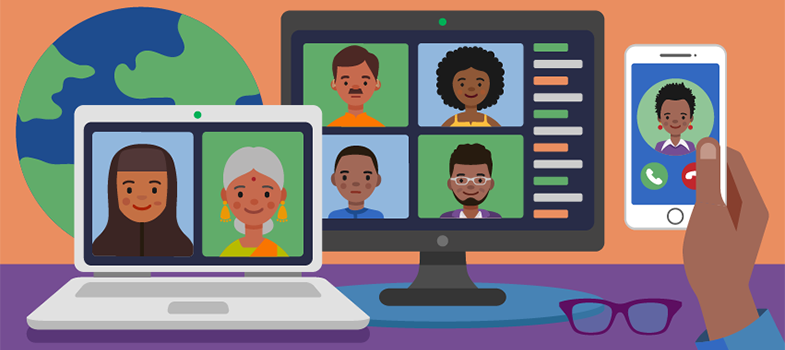Social media and messaging tools
Facebook, WhatsApp, Twitter and other social networking tools are widely used for communicating and sharing with friends, family and the wider world, but they can also be useful in online learning because they are familiar and help to encourage collaboration.
In this video, Charlotte, an international development consultant, talks about how she and her team used Whats App to move their training online. (If you have already studied the section called ‘Knowing Your Learners’ you may not wish to watch this video again.)

Transcript
CHARLOTTE CHISHAVA:
So, what I'm going to share with you is an experience that we as a programme are going through, as a way to adapt the way that we do capacity development for our volunteers during this COVID era. We were one of the organisations that used to do face-to-face trainings, because we totally believed that children interaction plays a key role in building skills, knowledge, and attitudes that are essential in implementing a programme. But, unfortunately, due to COVID, we couldn't meet, so we had to adapt the way that we interact with our volunteers fast.
One of the things that we ended up settling for, as a programme, is the use of WhatsApp. Why the use of WhatsApp is because we thought every volunteer had a phone, every volunteer could type, and every volunteer could buy, you know, bundles. They are really cheap, and it would enable them to then just give an interaction within the platforms.
But I must say things are not always as we expect them to be. Yes, people had phones. Yes, they had experience in typing, but the experience we later learned during our trainings is that we would, for example, ask our volunteers to use emojis just to show their presence in a workshop. For some, with big phones, it was easy. They would quickly look for a smiley and then press on it. And voila -- it comes.
But for some with small phones that need extra buttons they had to work extra hard to get to that image, and sometimes it would take a lot of time than anticipated, meaning by the time they get to see the image and send it, we would be doing question number one, question number two. So that was the biggest problem that we noticed.
The second thing that we noticed is that not everyone was quick in typing and reading. So, in a group WhatsApp platform where you have about 40 participants, everyone is busy typing an answer in response to what the facilitators asked. One wants to read and check whether what they want to write has not already been mentioned. One wants to also learn what others are saying. At the same time, they also want to concentrate with putting their response to the question. By the time they actually press Enter, what will happen is we are on question number 3. So, we realised that pace, typing skills, general knowledge, and appreciation of WhatsApp functions were crucial, and were things that we had taken for granted, mainly because we just thought everyone works with WhatsApp.
How we have managed to work around this problem is that we have introduced another module where we still use WhatsApp platforms, but what we now do is we send information in advance to different groups, so they're working groups of about five volunteers at a time. They read through the materials. They discuss in their free time before the actual training date.
When they come for the actual training date, what they then do is they are simply giving feedback to what they've discussed as a group. The good part about this is that it enables different groups to share experience that they actually do within their school hubs It enables participants to ask each other questions, comments, clarifications on why they've done things in a certain way. And it enables, for example, the facilitator to give the leading role to the participants, because they then determine what is crucial to understand within the training itself, and what new ideas they are then -- what they're picking, unlike our old model, where everything used to be sent out to the group, then the facilitator -- then they would get to summarise it for everyone for them to be on the same level.
If you are planning to use social media, a first and essential step is to check that all your learners have access to the tool you are thinking of and are comfortable using it. You should check the terms of your organisation’s social media policy, if it has one. You’ll also want to consider privacy and security, so you will probably need to set up a closed group only accessible to you, your learners and any others you want to invite, rather than being open to anyone. (Note that this is not possible with some of these networking tools.) Your learners may also have concerns about sharing and use of data so make sure everyone understands how and with whom they may share information if they use social media.
Whether you incorporate social media in your training or not, there will always be the possibility of interactions between learners in spaces away from the ‘official’ locations. Although the lack of control of such spaces may be a cause for concern, they can be a great help for learners by providing peer-to-peer support. For example, if they are in touch with each other via an instant messaging app such as WhatsApp during an online learning event they can often help each other with understanding the issues covered.
Tip
For any of the tools and technologies you may be considering, a simple online search will almost always bring up helpful videos and guides on what they offer and how to use them.
Activity: Social media in online training
Think about your own experience of using social media and consider the possible pros and cons of using it for teaching and training. If you are short of ideas, read The Use Of Social Media In Online Training: Benefits And Drawbacks by the eLearning Industry [Tip: hold Ctrl and click a link to open it in a new tab. (Hide tip)] , an article that summarises some key benefits and drawbacks. It is written for the commercial sector but is also relevant in other contexts.
Note down your pros and cons in the table below.
| Pros (benefits) | Cons (drawbacks) |
|---|---|
Discussion
The main points from the article are summarised here. You may have your own answers as well.
| Pros (benefits) | Cons (drawbacks) |
|---|---|
|
|
Video conferencing platforms

